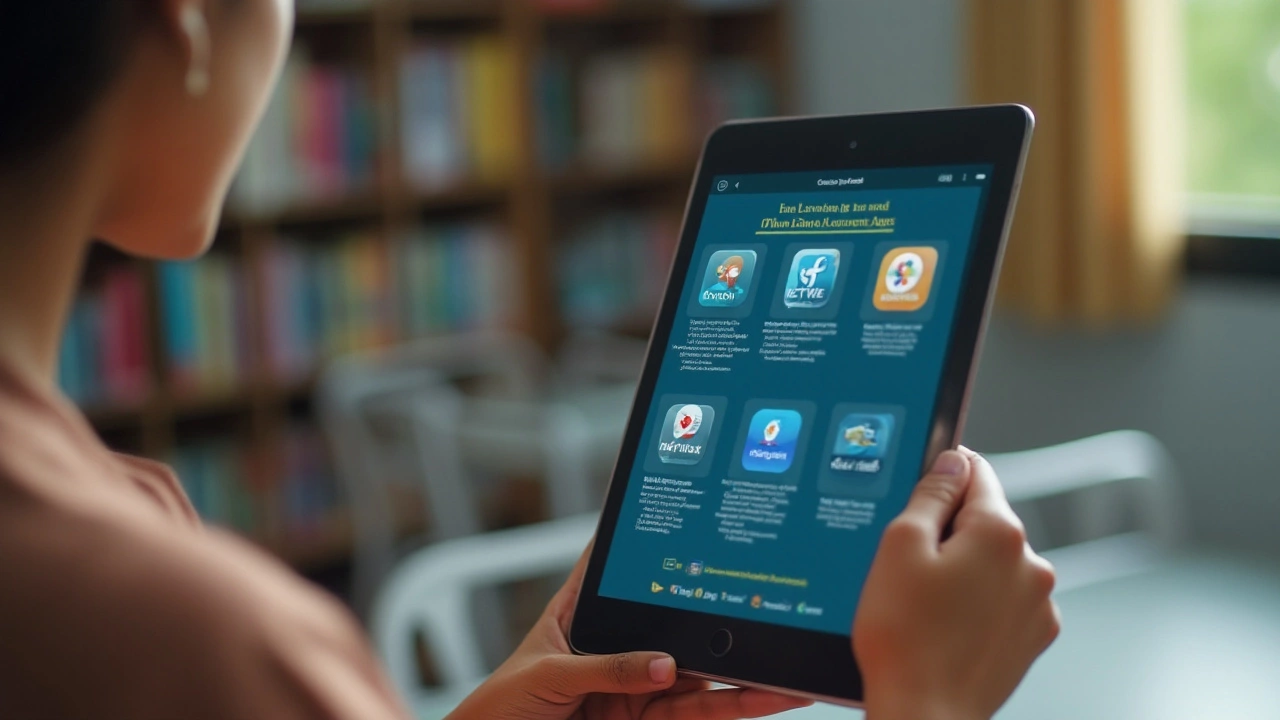In the rapidly evolving world of education, finding the right digital platform to facilitate online teaching is more important than ever. As educators continue to embrace the virtual classroom, the sheer number of e-learning apps can feel overwhelming. Each of these tools offers something different, from interactive features to user-friendly designs that enhance the educational experience.
This guide aims to help educators navigate the digital landscape by exploring the most effective apps available for teaching online in 2025. Whether you're new to e-learning or looking to upgrade your current toolkit, understanding the key features and benefits of each app can significantly influence teaching outcomes. Let's embark on this journey to find the right fit for your online classroom needs.
- Understanding E-Learning Platforms
- Key Features to Look For
- Popular Apps for Online Teaching
- Comparing App Interfaces and Usability
- Boosting Student Engagement with Technology
- Choosing the Right App for Your Needs
Understanding E-Learning Platforms
In recent years, e-learning platforms have revolutionized the way we perceive education. These digital learning environments have become vital for facilitating education beyond the confines of traditional classrooms, offering flexibility and accessibility to learners across the globe. At their core, e-learning platforms serve as the backbone of virtual education, enabling educators to deliver lessons, resources, and assessments efficiently. They range from simple content sharing websites to comprehensive systems that support synchronized and asynchronous learning. The variety in capabilities and design reflects the differing needs they are built to meet, providing tailored solutions for various educational contexts. Whether it's engaging quizzes, forums for discussion, or even collaborative projects, these platforms enable interactive learning practices that were once limited by geographical boundaries.
The technology behind e-learning platforms continuously evolves to offer increasingly sophisticated features. This includes video conferencing for real-time interaction, integrated assessment tools for tracking learner progress, and discussion boards to stimulate student engagement. International trends indicate a steady rise in e-learning adoption rates, spurred by the ongoing demand for remote learning solutions. A report by Educational Technology Research states that the global e-learning market is poised to grow by nearly $10 billion between 2023 and 2027, underscoring the rapid integration of technology in education.
The transition to digital learning is a significant pivot point for education systems worldwide, providing both opportunities and challenges, notes Sarah Thomas, an educational technology researcher at EduTech Insights.As technology advances, personalization has become a focal point for these platforms. Adaptive learning technologies can tailor assignments and feedback to the individual needs of students, thereby enhancing the overall efficacy of the learning experience.
Selecting the right e-learning platform is crucial for educators aiming to optimize the teaching and learning process. Several criteria should be considered when evaluating these platforms. First, ease of use is paramount; a steep learning curve can hinder adoption by both teachers and students. Secondly, the platform should support the educational goals of the institution or individual. This may include robust analytics to track student progress, flexibility in content delivery modes, and the ability to integrate with existing systems or tools. Thirdly, ensuring that a platform is accessible to all students, including those with disabilities, is an essential consideration. Educators should look for platforms with built-in accessibility features and compatibility with assistive technology. Potential limitations, such as internet connectivity and device compatibility, should also be addressed to ensure seamless access. To assist educators in their decision-making process, some e-learning platforms offer trial periods or demo versions, enabling users to explore features and functionalities firsthand.
Key Features to Look For
When diving into the myriad of e-learning platforms available in today's digital age, it's imperative to pinpoint specific features that will cater to both educators and students. The right platform should enhance the teaching and learning experience, not complicate it. One of the foundational attributes to consider is user-friendliness. This means an intuitive interface that doesn't require hours of training to understand. Even tech novices should feel right at home navigating through assignments, resources, and communication tools.
Another essential feature in an online teaching app is adaptability. A good platform should allow for customization, letting educators tailor course structures and content delivery to their unique styles and the needs of their students. For instance, the ability to integrate multimedia elements like videos, slides, and interactive quizzes can make a significant difference in how engaging and informative the learning experience can be. Additionally, flexibility in scheduling and assessments is crucial, as it accommodates various learning paces and obligations that students may have outside the classroom.
Interactivity plays a pivotal role in fostering engagement. A quality e-learning app will offer tools such as chat functions, forums, and even virtual breakout rooms for group activities. These features facilitate communication, collaboration, and peer-to-peer learning. As noted by online education expert Jane Holman, "The essence of effective online education lies in creating dynamic environments where students feel connected, motivated, and inspired to learn."
Security is another non-negotiable aspect when choosing an education technology platform. With sensitive information such as personal data, academic records, and payment details being part of the digital ecosystem, robust security measures including encryption and multi-factor authentication are essential. Parents and students need assurance that their data is protected, fostering trust in the digital learning environment.
Moreover, data analytics and tracking tools offer invaluable insights for educators. These features provide an overview of student progress, highlighting areas where they excel and where extra support might be needed. Detailed analytics can inform curriculum adjustments and personalized learning plans, ensuring every student has the best chance to succeed. Some platforms even incorporate artificial intelligence to predict patterns and tailor learning experiences automatically.
Finally, scalability and support are features that cannot be overlooked. An online teaching app should be able to grow alongside your educational needs, whether you're teaching a small group or scaling up to a global classroom. Reliable customer support, available 24/7, ensures that technical difficulties don't disrupt the learning process. An efficient help desk can be the difference between a minor hiccup and a major setback.

Popular Apps for Online Teaching
As the landscape of education continues to change, educators are turning to a variety of innovative e-learning platforms to better engage students and streamline the teaching process. Among these, Zoom has become a familiar name, offering a robust infrastructure for virtual classrooms. With its breakout rooms, screen-sharing capabilities, and the ease of recording sessions, teachers have found it instrumental in creating an inclusive educational environment. The app's adaptability allows instructors to host large classes while still providing the ability to focus on smaller group interactions, making it a versatile choice for those teaching diverse subjects.
Meanwhile, Google Classroom stands out for its seamless integration with a wide range of Google services, making it an ideal choice for institutions already entrenched in the Google ecosystem. Its straightforward, user-friendly interface allows educators to create assignments, provide feedback, and maintain an organized lesson plan with ease. The ability to make use of Google's extensive suite of tools, such as Google Docs and Sheets, enhances the ability to craft a highly interactive and engaging online teaching experience. This integration fosters a productive environment for both students and educators, emphasizing the collaborative aspect of learning.
Another noteworthy app is Microsoft Teams, which has become increasingly popular for its comprehensive feature set that includes chat, file sharing, and an opportunity for direct collaboration in a digital workspace. This app is particularly beneficial for institutions where education technology is essential for daily operations. In addition to supporting up to 500,000 users organization-wide, which is impressive in its own right, Teams also syncs effortlessly with the well-established Microsoft Office suite. This function allows for real-time editing and collaboration on documents, which is particularly useful for project-based learning formats.
For educators seeking a more interactive and gamified approach, Kahoot! offers a unique twist. This app makes it possible to create quiz-based learning experiences that cultivate an engaging and fun atmosphere. The use of gamification can significantly enhance student motivation, encouraging more participation and attentiveness in lessons. Global figures show that teachers using Kahoot! have reported a 20% increase in student engagement, proving its efficacy in a diverse array of educational settings. Such promising data underscores the impact that adopting technology in education can have.
"The integration of technology into the classroom not only increases engagement but also expands learning opportunities," said Dr. Samantha Lee, a renowned educational technologist and advocate for digital learning tools.
In considering which app might best suit a teacher's specific needs, it's essential to explore all the features and capabilities of each platform. Every app has its strengths, and understanding them can lead to a more fulfilling and effective educational experience for everyone involved. As we move further into 2025, the marriage of technology and pedagogy promises to redefine how and where learning happens—it’s an exciting time for education professionals to innovate!
Comparing App Interfaces and Usability
Navigating the world of e-learning platforms can feel like a colossal task, particularly when each application boasts a user interface that seems designed to dazzle. Yet, as any seasoned educator will tell you, the secret to a successful online classroom lies not just in flashy features, but in an intuitive design that makes teaching and learning a seamless experience. Let's take a deep dive into some of the most popular online teaching apps and evaluate them based on their interface and usability. What really sets them apart is how each balances ease of navigation with powerful educational tools, offering teachers and learners an experience that's both comprehensive and comprehensible.
Firstly, consider the app Schoology. It's well-regarded for a sleek layout that mirrors social media platforms, making it approachable for both teachers and students alike. With its simple drag-and-drop features for course content and an engaging user experience, Schoology helps educators easily manage assignments, discussions, and grading. Many teachers appreciate how its design eliminates unnecessary complexity, ensuring focus remains on what counts: the teaching itself.
On the other hand, Canvas is a heavyweight that offers a robust set of features that go beyond the surface. Its interface, while more complex, provides extensive customization options, allowing teachers to mold their courses precisely to fit their needs. This might mean a steeper learning curve initially, but the returns in course personalization can justify the initial time investment. As one educator noted, "Canvas offers a deeper layer of interactivity, which when mastered, completely transforms the learning dynamic."
"The perfect user interface is not just about simplicity; it's about reducing the cognitive load on the user while enhancing functionality," suggests education technology expert Carla Dawson.
Another platform, Google Classroom, exemplifies simplicity. Known for its seamless integration with other Google services, its interface emphasizes clarity and ease-of-use. For teachers already familiar with Google Workspace, it's a natural extension of their toolkit, allowing for efficient document sharing, real-time collaboration, and automated organization. This user-friendly nature makes Google Classroom a favorite, especially in institutions where time and resources to train staff on new technologies are limited.
But what about Zoom and Microsoft Teams, apps originally designed for business but now staples in education as virtual classrooms? These platforms have adapted to educational needs, offering breakout rooms, quizzes, and integrations with other educational software. Microsoft Teams, in particular, integrates with OneNote and other Microsoft services, providing a unified hub for all educational activities. Although their interfaces can initially appear corporate, their usability adapts well to an educational context, making them strong contenders in the realm of education technology.
In assessing any app's usability, data and user feedback are crucial. A table from the "Global E-Learning Survey 2024" painted an insightful picture of user satisfaction:
| App | User Satisfaction (%) |
|---|---|
| Google Classroom | 85 |
| Schoology | 80 |
| Canvas | 75 |
| Microsoft Teams | 70 |
| Zoom | 65 |
Ultimately, the right platform for an educator will depend on specific needs, tech savviness, and the age group of the students involved. The key is finding a balance between a virtual classroom interface that feels as familiar as possible while being equipped to handle the rigors of modern education. After all, the ultimate goal is an engaging, efficient learning experience where neither students nor educators have to wrestle with technology.

Boosting Student Engagement with Technology
In today's digital era, sustaining student engagement in virtual classrooms can be a thrilling yet challenging feat. As traditional learning environments transition to the online realm, educators are tasked with making lessons as captivating as they are informative. This is where e-learning platforms truly shine, offering a myriad of technological tools designed to enhance student interaction. Features such as interactive quizzes, real-time feedback, and multimedia presentations not only make lessons more lively but also cater to different learning styles. The visual, auditory, and kinesthetic learners can all find something that speaks to them, making online teaching apps indispensable in modern education.
E-learning platforms often integrate gamification elements to transform mundane tasks into fun challenges. This can dramatically heighten motivation among students, as they earn badges or move up levels by completing assignments. Such systems create a sense of achievement, turning even the most reluctant learner into an eager participant. According to research published by the Journal of Educational Technology in 2023, incorporating gamified elements can increase student participation by 40% and comprehension by 30%. With e-learning apps, educators can seamlessly incorporate such elements into their teaching strategy.
Interactive Features
Another striking feature of these e-learning platforms is their ability to facilitate real-time interaction. Instant messaging, video conferencing, and collaborative projects are just a click away, providing students with an avenue to express their thoughts freely. This immediacy not only removes the barriers of a physical classroom but also encourages shy students to voice their opinions without fear of judgment. A 2022 report by the School of Digital Learning highlights that using chat and forums can improve peer interaction by up to 50%, fostering a more inclusive educational environment.
"Technology is best when it brings people together," emphasized Matt Mullenweg, co-founder of WordPress, underlining the essence of engagement through technology.
Analytics and Feedback
Advanced e-learning platforms provide invaluable insights into student performance through analytics. Educators can track progress, identify areas of struggle, and customize their teaching approaches accordingly. This real-time feedback loop is crucial for maintaining student engagement, as learners receive immediate guidance on their strengths and areas for improvement. It empowers them to take charge of their learning journey with confidence. In fact, data from the International Society for Technology in Education suggests that students who receive regular feedback are 45% more likely to experience academic success.
As we dive deeper into the digital age, the potential for technology to keep students engaged is boundless. The key lies in selecting education technology tools that resonate with the interests of today’s tech-savvy learners, making online education an enriching experience for all.
Choosing the Right App for Your Needs
Deciding on the right app for online teaching isn't as straightforward as it might seem. The modern educator is spoiled for choice but must carefully consider what each platform brings to the table before committing. The journey begins with assessing your unique teaching style and classroom needs. Are you more inclined to lecture with interactive slides, or do your lessons thrive on collaborative activities? What you require from an e-learning platform might be vastly different from what another educator needs.
The type of students you are teaching can also play a significant role. Some learners benefit greatly from video-based content, while others engage more with text-based or interactive modules. When choosing an app, focus on which tools will foster the best environment for your students. Of course, ease of use for both the educator and students remains paramount. A user-friendly interface is as valuable as the features the app boasts. The goal is to ensure that neither you nor your students are bogged down by complicated navigation, thereby ensuring a smooth teaching and learning experience. Online teaching apps like Zoom, Google Classroom, and Microsoft Teams frequently come up as top choices, but understanding their subtle differences can make your decision more informed.
Cost is another significant consideration. Many high-quality apps offer a tiered pricing model, catering to various levels of functionality — often a basic version for free and premium options at a cost. Educators should weigh the free features against what you would gain with a subscription. Investing in a premium solution might be worthwhile if it includes features that enhance your teaching, like advanced analytics, increased storage, or expanded video conferencing capabilities. This brings us to the crucial aspect of support and training resources. An app's effectiveness relies heavily on the support it offers. Look for platforms backed by robust support teams and resources that help educators maximize the technology's potential.
According to a survey by the International Society for Technology in Education, nearly 85% of teachers reported improved student engagement when using interactive apps that provided thorough training tools.Understanding and utilizing these resources will ensure you spend less time troubleshooting and more time focusing on what truly matters — teaching. Finally, never underestimate the power of trial periods. Most successful platforms offer free trials or a demo, allowing educators to test the core functionalities before fully investing. This hands-on experience is invaluable, providing insights into how the app fits into your teaching routine and meets student needs.
This decision, albeit challenging, can fundamentally transform your teaching experience, breathing life into your virtual classrooms. By focusing on your teaching style, student needs, budget, and available support, you’ll find an app that not only supports your objectives but enhances your educational impact. E-learning technology isn't merely a tool; it’s an integral part of shaping the future of education.
